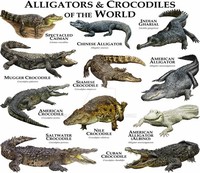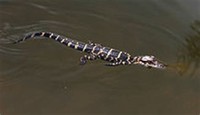Facts about Alligator

According to the Everglades National Park website, the largest alligator ever recorded in Florida was 17 feet, five inches long (5.3 meters).

An average American alligator's weight and length is 800 pounds and a little over four meters (13 feet) long.

Alligators, unlike the large crocodiles, do not immediately regard a human upon encounter as prey.

The market for alligator meat is growing and approximately 300,000 pounds of meat is produced annually.

The largest of the species (both males and females), will defend prime territory; smaller alligators have a higher tolerance of other alligators within a similar size class.

Smaller alligators often can be found in large numbers in close proximity to each other.

An alligator's lifespan is usually estimated in the range of 50 years or more.

Both living species of alligators (Alligator mississippiensis and Alligator sinensis) also tend to be darker in color, often nearly black but color is very dependent on the water.

Alligators consume food that cannot be eaten in one bite by allowing it to rot or by biting and then spinning or convulsing wildly until bite-size pieces are torn off.

The American alligators normally live along the coast of the Gulf of Mexico, Texas, Oklahoma, Louisiana, Mississippi, Alabama, and Florida as well as Arkansas, Georgia and the Carolinas.

Alligators' main prey are smaller animals that they can kill and eat with a single bite.

American alligators live in freshwater environments, such as ponds, marshes, wetlands, rivers, and swamps, as well as brackish environments.

The stomachs of alligators often contain gastroliths, rocks that are held in the digestive tract to help with grinding the food.

The largest alligator ever recorded measured 19 feet, two inches (5.8 meters) and was found on Marsh Island, Louisiana.

Alligator farming is a big and growing industry in Florida, Texas, and Louisiana.

The majority of American alligators inhabit Florida and Louisiana.

Alligators are opportunistic feeders, eating almost anything they can catch.

Adult alligators can take razorbacks and deer and are well known to kill and eat smaller alligators.

The name alligator is an anglicized form of the Spanish el lagarto ("the lizard"), the name by which early Spanish explorers and settlers in Florida called the alligator.

According to the Florida Department of Agriculture, raw alligator meat contains roughly 200 calories per three ounce serving size, of which 27 calories come from fat (Collins 2007).

The United States is the only nation on earth where both alligators and crocodiles live side by side.

Alligator is the common name for large, primarily aquatic reptiles that belong to the genus Alligator of the family Alligatoridae and order Crocodilia.

The eyes of a large alligator will glow red and those of a smaller one will glow green when a light is shined on them.

An American alligator is generally considered mature when it reaches a length of six feet or more.

Most of the muscle in an alligator's jaw is intended for biting and gripping prey.

The Chinese alligator is endangered and lives only in the Yangtze River valley, though currently Rockefeller Wildlife refuge in southern Louisiana has several in captivity in an attempt to preserve the species.

Alligators are generally wary of humans and tend to walk or swim away if one approaches.

The true alligators are now restricted to two species—Alligator mississippiensis in the southern United States and the small Alligator sinensis in the Yangtze River, People's Republic of China.

The Chinese alligator is smaller, averaging about 1.5 meters (five feet) in length, and rarely exceeding two meters (seven feet).

The family Alligatoridae also includes the caimans, and the order Crocodilia also includes the true crocodiles (family Crocodylidae).

The maturity of the alligator is dependent more upon the size of the animal than its age.

Feeding alligators has led to some of the alligators losing their fear of humans and in turn, choosing to approach humans instead of moving away.

Alligator hides bring good prices and hides in the six to seven foot range have sold for $300 each, though the price can fluctuate considerably from year to year.

The young alligators remain near their mother for at least two to three months, but often as long as two to three years (Grzimek et al.

Alligators have been seen as far north as Memphis, Tennessee, presumably arriving there by swimming up the Mississippi River.

The largest threat to young alligators are adults, accounting for nearly a fifty percent mortality rate in some cases.
As they wear down, they are replaced. An alligator can go through 3,000 teeth in a lifetime. Male alligators are larger than female alligators. The average adult size for a female is 8.2 feet (2.6 meters), and the average size for a male is 11.2 feet (3.4 meters).
Gators serve a purpose in our environment. American alligators are fast, agile and usually afraid of humans. They are the largest reptile in America and serve a critical role in keeping our ecosystem in balance. ... These "gator holes" can be a source of lifesaving water for fish, birds, turtles and other creatures.Feb 14, 2013
Different Snouts. One of the main differences between alligators and crocodiles is the snout. The alligator's is broader and shaped like a U, whereas the crocodile's is longer and narrower and more V-shaped. The alligator bite is more powerful, because it is specialized for breaking open things like turtle shells.Aug 13, 2017
Alligators can often reach at least 14 or 15 feet in length, which is larger than some crocodile species, but not others. The largest crocodile species is the saltwater crocodile, which can get to at least 17 or 18 feet - some rare individuals exceeding 20 feet after many years.
While all gator served in restaurants must be farm raised, local hunters are allowed to kill one alligator each year. Most gators served in restaurants are on the small side (about two to three feet in length), but these daring sportsmen typically hunt 10 to 12 foot alligators, freeze them, and eat them all year long.Mar 23, 2016
It has been described as a healthy meat source for humans due to its overall composition and for being low in fat and high in protein. Alligator meat has been described as having a mild flavor and a firm texture. It tastes like chicken, with a mildly fishy flavor, and is often chewy, depending on preparation.
Place alligator meat in a medium bowl, and mix with vinegar, salt, and pepper. Cover, and refrigerate about 10 minutes. Pour oil into a large skillet to a depth of 1 inch, and heat over a medium-high flame. Add to a large resealable bag the flour, cornmeal, garlic powder, cayenne pepper, and black pepper.